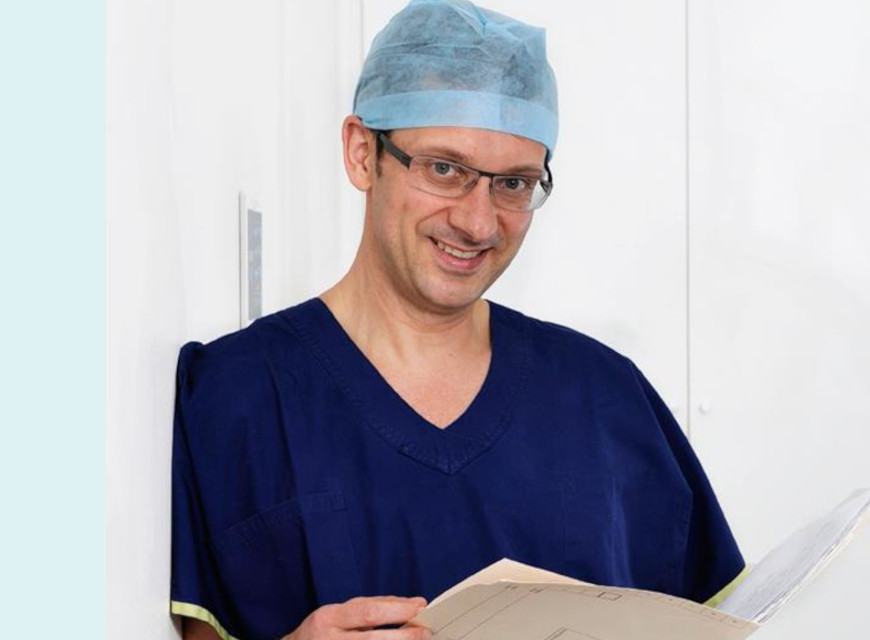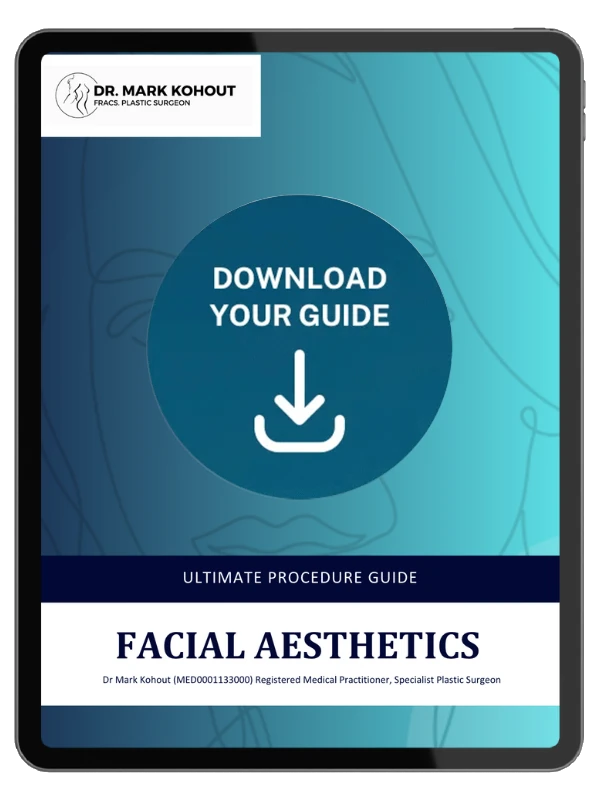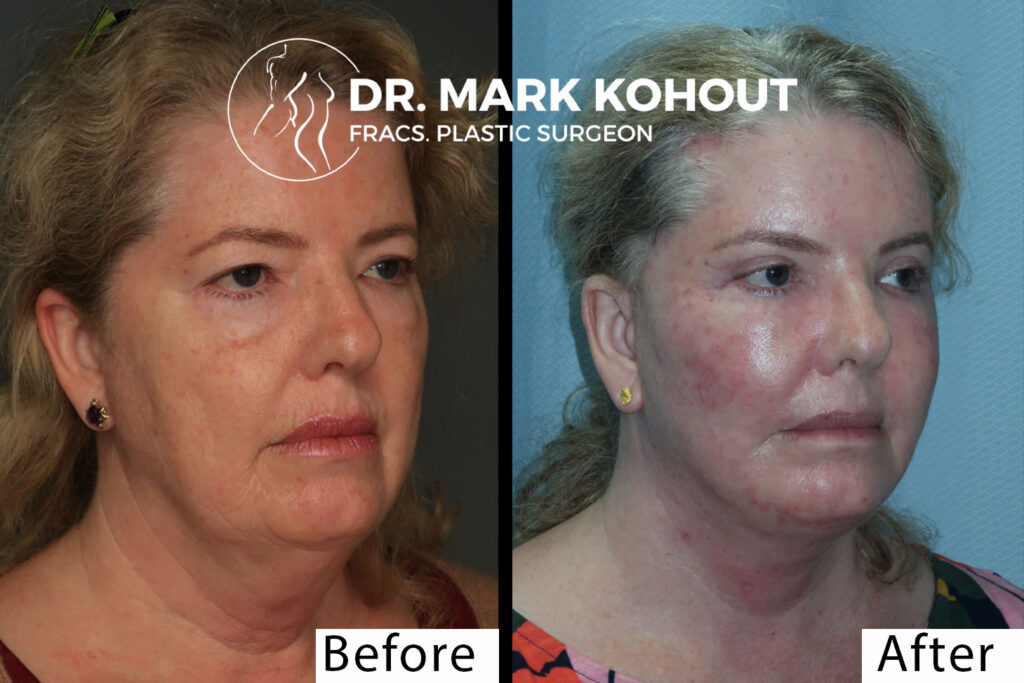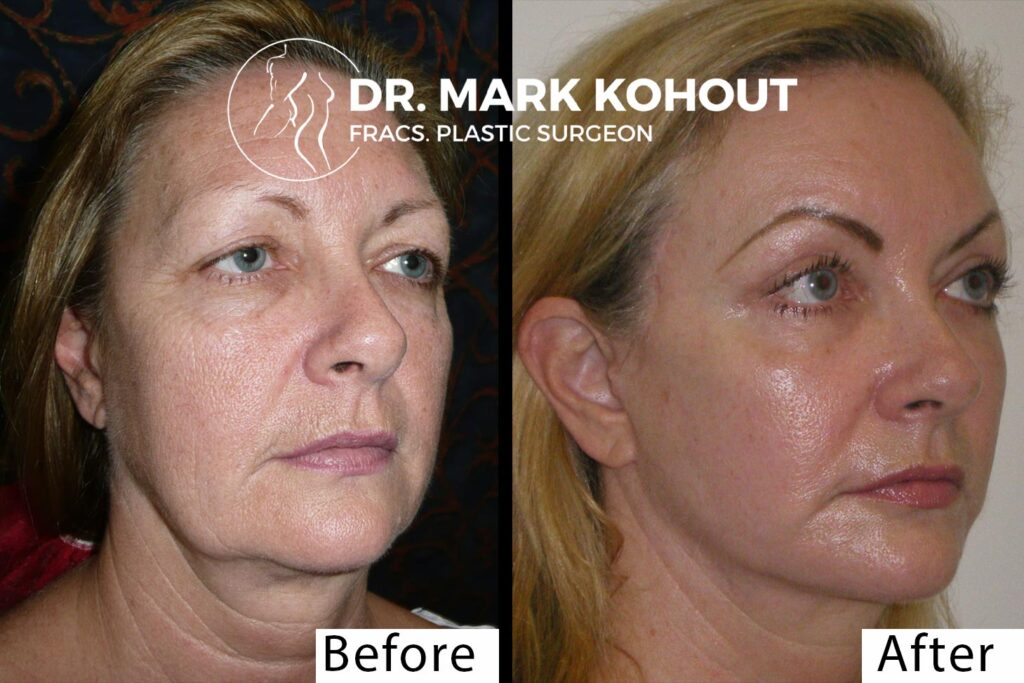
Facelift surgery, or rhytidectomy, is a procedure that addresses visible changes in the mid to lower face and the neck that develop gradually over time. For individuals considering this procedure, one of the most important aspects to understand is not only how the surgery is performed, but also what the recovery process involves. Recovery plays a central role in achieving the intended surgical outcome and requires both preparation and patience.
In Sydney, Dr Mark Kohout, Specialist Plastic Surgeon, provides patients with comprehensive guidance on facelift surgery, including a clear discussion of healing, timelines, and aftercare. In this article, we will examine the different stages of recovery in detail, highlight the factors that influence the pace of healing, and provide a realistic overview of what patients may experience in the days, weeks, and months following their procedure.
Understanding Facelift Surgery In Context
A facelift involves repositioning the deeper tissues of the face and removing or redraping excess skin in order to refine the contours of the lower face and neck. The procedure does not prevent the natural ageing process, but it is designed to address visible signs such as loose skin, changes in jawline definition, or folds that develop in the cheek and neck region.
In Sydney, men and women in a wide age range often explore facelift surgery as part of their decision-making process. Some are interested in addressing age-related changes, while others are concerned with early signs of skin laxity that are not well managed through non-surgical treatments. Regardless of the motivation, it is important to understand that recovery is a gradual process. Results emerge progressively rather than instantly, and every patient will have a different experience depending on their individual healing response and the surgical technique used.
Immediate Recovery: The First 24–48 Hours
The first two days following facelift surgery represent a critical period where the body begins to heal from the procedure. Patients are usually monitored in a recovery setting to confirm that vital signs such as blood pressure remain stable and that immediate post-operative needs are addressed. In some cases, patients may remain in hospital overnight, while others are discharged on the same day depending on the extent of the procedure and their overall health.
During this stage, dressings are often placed around the face to protect incision sites and to help reduce swelling. Some patients may have small drains placed to prevent the accumulation of fluid beneath the skin. Swelling, bruising, and a sensation of tightness are normal experiences at this point, and prescribed pain medication is typically used to manage discomfort. Patients are usually encouraged to rest with their head elevated to help minimise swelling and to avoid movements that place unnecessary strain on the healing tissues.
Having support from a friend or family member is highly beneficial during these first 48 hours. Assistance may be needed with meals, personal care, and general mobility as patients adjust to the initial effects of surgery.
The First Week After Surgery
The first week following facelift surgery is often when swelling and bruising are most noticeable. Patients are advised to focus on rest, hydration, and gentle activity, with care taken to avoid bending or heavy lifting. Walking slowly around the home helps promote circulation, but any strenuous movement is avoided.
During this time, patients usually attend their first follow-up appointment with Dr Mark Kohout in Sydney. At this visit, dressings may be replaced or removed, and drains, if placed, are often taken out. The surgeon carefully examines the incision sites and overall healing, answering any questions the patient may have about aftercare. Mild discomfort, changes in skin sensation, or feelings of tightness are common but generally improve steadily each day. Patients are reminded that visible bruising and swelling are expected and form part of the normal recovery process.
Weeks Two To Four: Gradual Improvement
Between the second and fourth weeks, most patients notice a significant improvement in their comfort and appearance. Swelling and bruising gradually begin to resolve, allowing the underlying changes to become more visible. Many individuals begin to feel comfortable enough to return to work, particularly in roles that do not require physical exertion. Others may start to participate in limited social activities.
During this stage, some residual swelling may persist, and the face may continue to feel slightly tight or numb in certain areas. These sensations are temporary and usually improve with time as the nerves and tissues recover. Patients are sometimes cleared to apply makeup to conceal any lingering bruising, provided the surgeon agrees that incision sites have healed sufficiently.
Although patients often feel more energetic during this period, they are encouraged to remain cautious about physical exertion. Exercise, particularly activities that increase blood pressure, is usually delayed until at least four to six weeks after surgery, depending on individual healing progress.
Long-Term Recovery And Healing Process
By four to six weeks after surgery, many patients are able to resume their normal routines, including work, social engagements, and travel. However, it is important to understand that the healing process continues well beyond this point.
Scar maturation is one of the most significant long-term aspects of recovery. Incisions are typically placed along the hairline and around the ears, which helps to reduce their visibility. Initially, scars may appear pink, firm, or raised, but over time they soften and fade. This process often takes several months and is supported by careful skincare and sun protection.
Tissues also continue to settle during this period. Subtle changes occur as swelling fully resolves and the repositioned tissues adapt to their new structure. Final results become more apparent after several months, although many patients are pleased with their progress by the end of the first six weeks. Patience is important, as the most refined outcome takes time to develop.
Factors That Influence Recovery
Every patient’s recovery after facelift surgery is unique. Age plays a role, as younger patients often heal more quickly, while older patients may experience a slower process. General health and wellbeing also make a significant difference. Patients who maintain a healthy lifestyle with good nutrition, regular exercise, and avoidance of smoking generally recover more smoothly.
The surgical technique itself also influences recovery. A more extensive facelift involving multiple layers and broader incisions may require longer healing, whereas less extensive approaches may result in shorter recovery timelines. However, it is important to remember that shorter recovery does not necessarily mean better, as each technique is chosen to address a patient’s specific needs and anatomy.
Finally, the extent to which patients adhere to post-operative instructions plays a vital role. Following guidance on wound care, activity restrictions, and follow-up appointments help confirm that healing is progressing as expected and that potential complications are identified early.
Evidence-Based Approaches In Facelift Recovery
Ongoing research in plastic surgery continues to refine the strategies used to support recovery after facelift procedures. Blood pressure management has become a central focus, as maintaining stable blood pressure in the immediate post-operative period is associated with a lower risk of developing complications such as hematomas. Surgeons may use specific medications and monitoring techniques to help control blood pressure during the first days after surgery.
The use of dressings and drains also varies depending on the surgeon’s approach. Some use traditional bandages, while others employ newer techniques such as a hemostatic net, which has shown promising results in reducing bleeding and bruising. These approaches are tailored to the individual and reflect the surgeon’s training and experience.
In addition, some surgeons use tranexamic acid, a medication that can reduce bleeding and bruising when administered during surgery. While not used for every patient, it represents an emerging approach supported by growing evidence. Importantly, these measures highlight that recovery is guided by a combination of surgical expertise, medical knowledge, and individualised care.
Caring For Yourself During Recovery
Patients play an active role in their recovery process. Simple daily practices can make a significant difference. Resting with the head elevated helps reduce swelling, while maintaining good hydration and eating a nutrient-rich diet supports tissue repair. Foods high in protein, vitamins, and minerals are particularly beneficial for wound healing.
Avoiding smoking and alcohol is critical, as both can compromise circulation and delay recovery. Patients are also encouraged to carefully follow instructions on incision care, including when and how to clean the area and when to apply topical products if recommended. These steps reduce the risk of infection and promote optimal healing.
Preparing in advance for recovery can make the experience smoother. Some patients arrange time off work, organise help at home, or prepare meals and household tasks in advance to minimise stress during the early recovery period.
Emotional And Practical Considerations
Recovery after facelift surgery involves not only physical healing but also practical and emotional adjustment. Many patients prefer to limit social interactions in the first few weeks while bruising and swelling are visible. Planning time away from professional responsibilities can help avoid pressure and allow for more restful recovery.
Support at home can also be an important factor. Assistance from a family member or friend with cooking, shopping, or transportation reduces the need for strenuous activity and provides reassurance.
It is also normal for patients to experience an emotional adjustment during recovery. Early swelling can temporarily obscure results, and it may take several weeks before changes align with expectations. By preparing for this emotional component, patients can better manage their recovery with realistic expectations.
Risks, Complications, And When To Contact Your Surgeon
While most patients recover well after facelift surgery, it is important to recognise that risks and complications are possible. Common and expected symptoms such as swelling, bruising, and mild discomfort are part of normal healing, but unusual or severe symptoms may require medical attention.
Patients should contact their surgeon promptly if they experience sudden swelling, severe pain, signs of infection such as redness or discharge, or persistent bleeding. Regular follow-up appointments with Dr Mark Kohout in Sydney provide an opportunity to monitor healing, address concerns, and make adjustments to aftercare as needed.
Key Takeaways For Patients Considering Facelift Surgery In Sydney
Recovery after facelift surgery is a progressive journey that takes place over weeks and months. The first two weeks are typically marked by swelling and bruising, while improvements become more noticeable between the second and fourth weeks. By six weeks, most patients resume their normal routines, though scar maturation and subtle refinement continue for several months.
Each patient’s recovery is influenced by age, health, lifestyle, surgical approach, and adherence to aftercare instructions. Personalised guidance from a Specialist Plastic Surgeon in Sydney ensures that patients receive the support and monitoring needed throughout the healing process.
FAQs About Recovery After Facelift Surgery
How Long Will My Face Feel Tight After Facelift Surgery?
A sensation of tightness is common in the first few weeks as swelling subsides and tissues adjust. For many patients, this feeling gradually eases over several months as healing continues.
When Can I Safely Wash My Hair After Facelift Surgery?
Patients are often advised to wait until after their first follow-up appointment before washing their hair. The exact timing depends on the healing of incision sites and the type of dressings used.
Is It Normal To Experience Numbness In The Cheeks Or Ears?
Yes, temporary numbness or altered sensation is expected after facelift surgery. This occurs because nerves in the skin are affected during the procedure. Sensation usually improves with time, although the timeline varies.
Can I Sleep On My Side During Recovery?
In the early weeks, most surgeons recommend sleeping on your back with your head elevated to reduce swelling and protect incision sites. Side sleeping is usually possible later, once tissues have healed more securely.
What Happens If I Accidentally Bend Over Or Lift Something Heavy Too Soon?
Occasional bending or lifting is unlikely to cause major problems, but repeated strain can increase swelling or bleeding risk. Patients should follow their surgeon’s guidance on activity restrictions to support safe healing.
Will Scars Always Be Visible After A Facelift?
Incisions are generally placed along natural lines around the hairline and ears to make scars less noticeable. They are more visible in the early months, but most fade significantly over time with proper care.
How Will I Know If Something During Recovery Is Not Normal?
While swelling, bruising, and mild discomfort are expected, sudden or severe changes such as sharp pain, rapidly increasing swelling, or signs of infection should be reported to your surgeon promptly for assessment.
Medical References
- Intraoperative Systolic Blood Pressure as a Significant Predictor of Postoperative Hematoma Following Facelift: Single-Surgeon Experience of 118 Consecutive Facelifts – Aesthetic Surgery Journal https://doi.org/10.1093/asj/sjae181
- Trends and dynamics in facelift surgery research: A bibliometric analysis – ScienceDirect https://www.sciencedirect.com/science/article/pii/S2096691124001109
- Long-Term Outcomes and Patient Satisfaction After Facelift Procedures – British Journal of Surgery https://academic.oup.com/bjs/article/111/6/715/5814021
Next Steps With Dr Mark Kohout
For individuals considering facelift surgery in Sydney, arranging a consultation with Dr Mark Kohout, Specialist Plastic Surgeon, is the most appropriate next step. During this appointment, patients can discuss their personal goals, review the details of the procedure, and gain a clear understanding of the expected recovery timeline. Potential risks and aftercare instructions are explained in detail, allowing patients to make informed decisions.
To learn more about facelift surgery and recovery, or to book a consultation, visit the website.
Further Reading
- Read more about Dr. Mark Kohout’s Cost of a Facelift in Sydney – Rhytidectomy Prices
- Read more about Dr. Mark Kohout’s Facelift Sydney
- Read more about Dr. Mark Kohout’s Can you Alter Your Chin? – All about Genioplasty Blog
Related Blog Posts
Recovery After Facelift Surgery: An In-Depth…
Undergoing facelift surgery is a significant decision that requires careful consideration. However, the journey doesn’t end when you leave the operating theatre. While the procedure aims to create a refreshed…
Different Techniques for SMAS Facelift
SMAS in Facelift Surgery: Insights from Dr Mark Kohout A facelift is a widely performed procedure aimed at addressing the face and neck areas. In this blog, Sydney Plastic Surgeon Dr Mark Kohout will…
Cost of a Facelift in Sydney
Exploring the Cost of a Facelift in Sydney: What You Need to Know A facelift, medically known as rhytidectomy, is a surgical procedure designed to address changes in the appearance of…

Experienced Plastic Surgeon
Dr. Mark Kohout
A qualified plastic surgeon who operates with care and integrity, based in central Sydney with over 20 years of experience in the cosmetic field. His extensive training and experience assures patients they are in highly trained surgical hands. Dr. Kohout is a dedicated, friendly professional who is committed to providing the high quality care, support and results, alongside his compassionate team.
Dr Mark Kohout (MED0001133000)
Specialist Plastic Surgeon
Specialist registration in Surgery – Plastic Surgery








